Abstract
BACKGROUND. An investigation of the relationship between incident human cases of Lyme disease and seroprevalence of antibodies to B. burgdorferi in dogs was undertaken in order to determine whether dogs might serve as sentinels for Lyme disease. METHODS. 3011 canine serum samples were analyzed by ELISA for antibody to B. burgdorferi. Records of incident human cases of Lyme disease were obtained from the Massachusetts Department of Public Health. RESULTS. Regression analyses of the relationship between the log10 (mean incidence in people 1985-1989) and canine seroprevalence from July 1988-August 1989 revealed that canine seroprevalence was highly predictive of incidence (R2 = 0.86, p less than .0001). A logistic regression model that incorporates the altitude of the town where each dog was resident, the date of sampling, and information on each dog's age, sex, and breed adequately explained the risk of canine seropositivity. Dogs resident at altitudes less than 200 feet, of sporting or large mixed breeds, and greater than two years of age were five times, four times, and almost three times more likely, respectively, to exhibit seropositivity than were other dogs. CONCLUSIONS. Estimates of the prevalence of antibody to B. burgdorferi in dog populations offers a sensitive, reliable, and convenient measure of the potential risk to people of B. burgdorferi in the environment. Risk factors for canine seropositivity may directly or indirectly illuminate certain aspects of the epidemiology of human Lyme disease.
Full text
PDF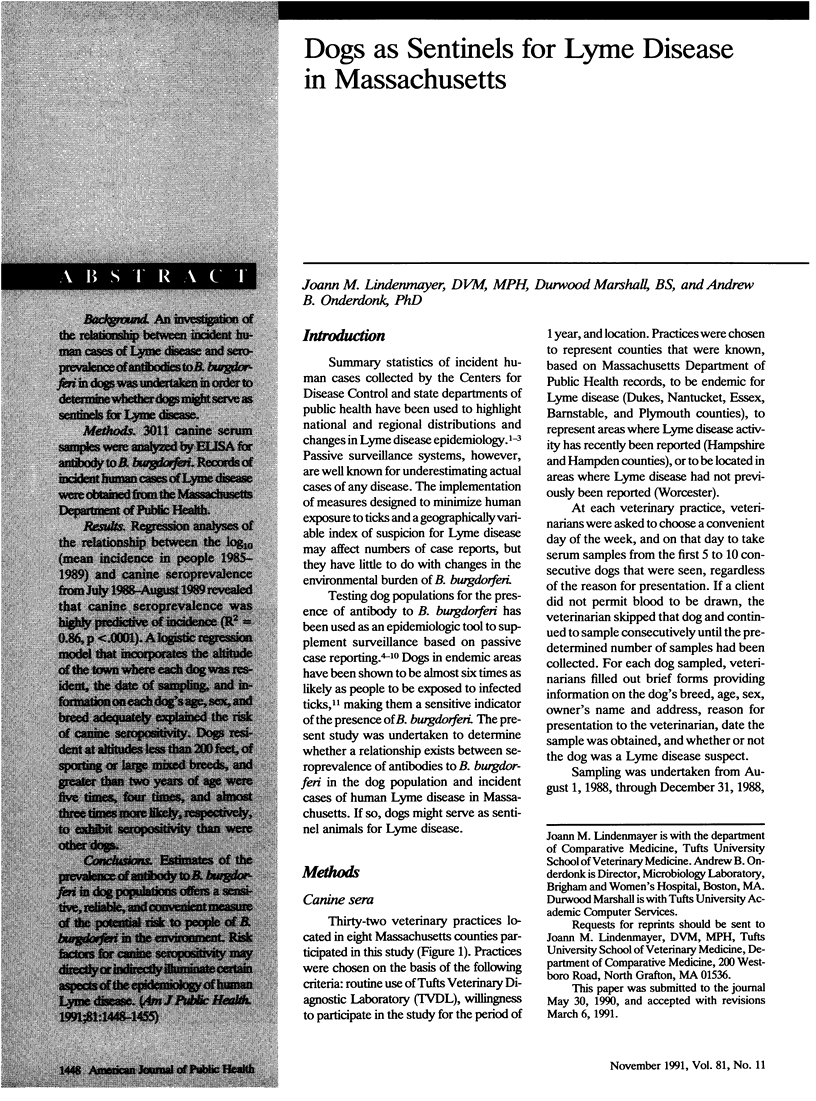
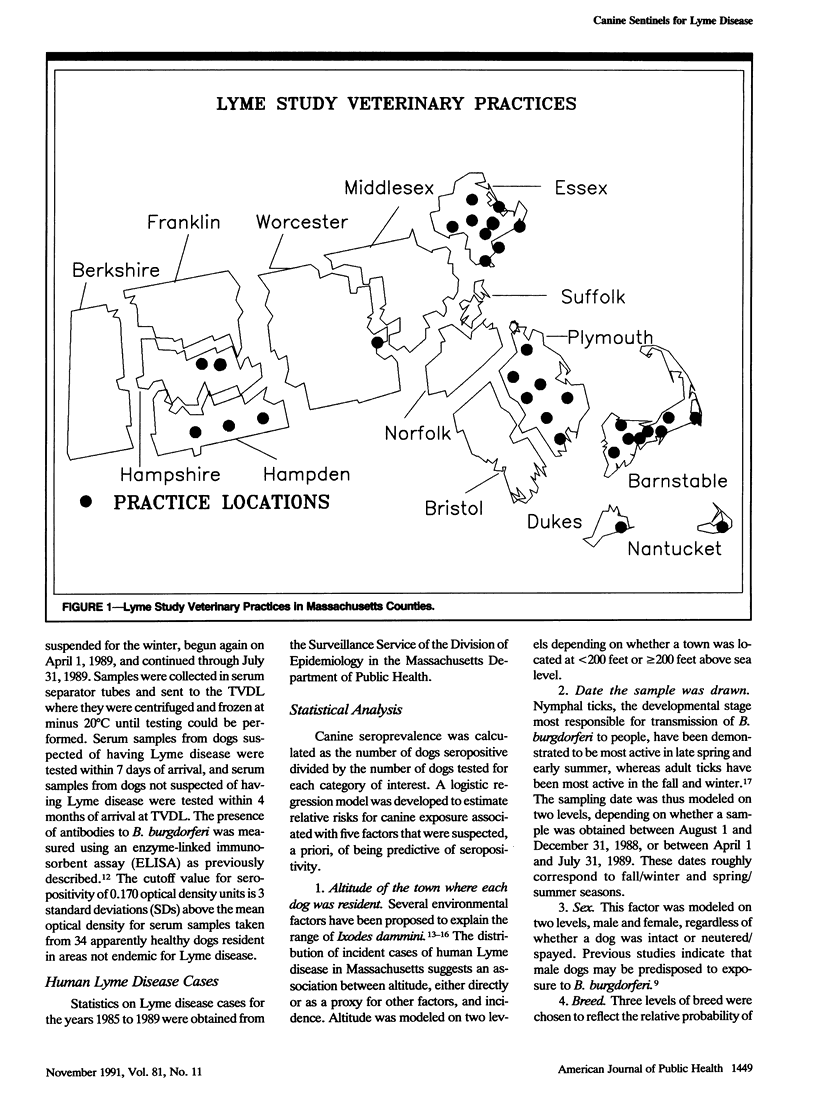
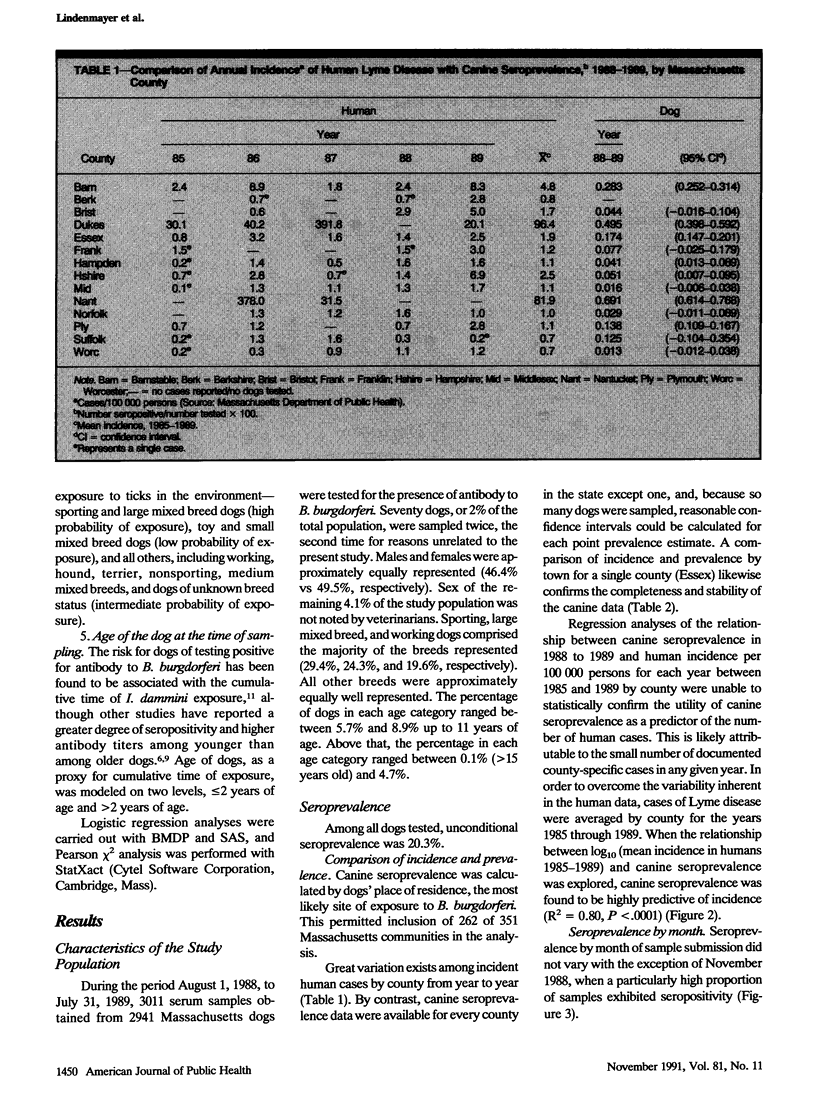

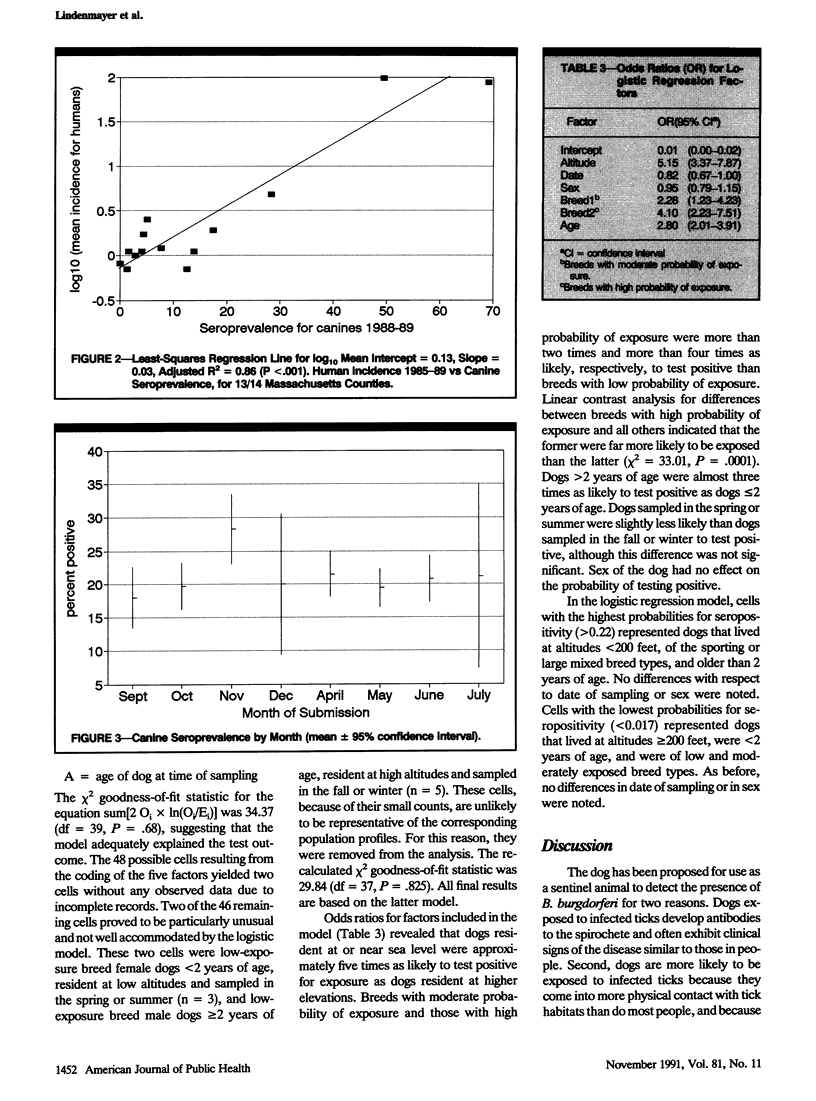
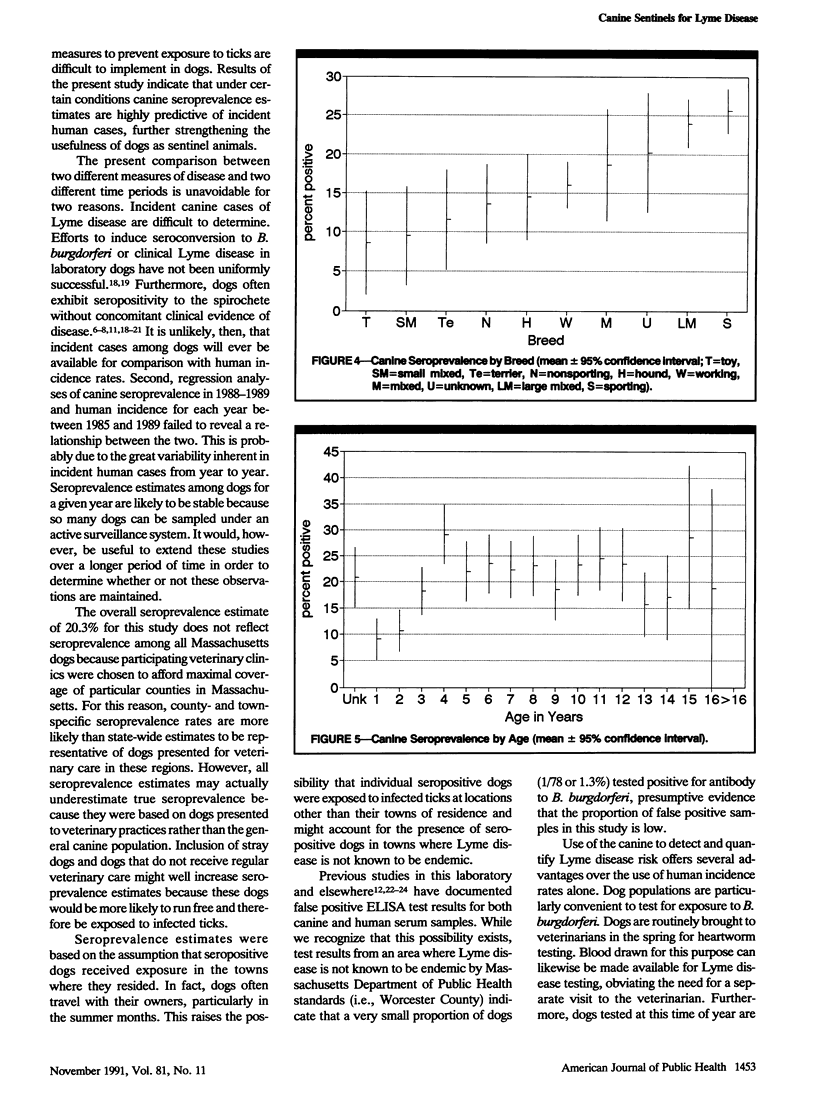
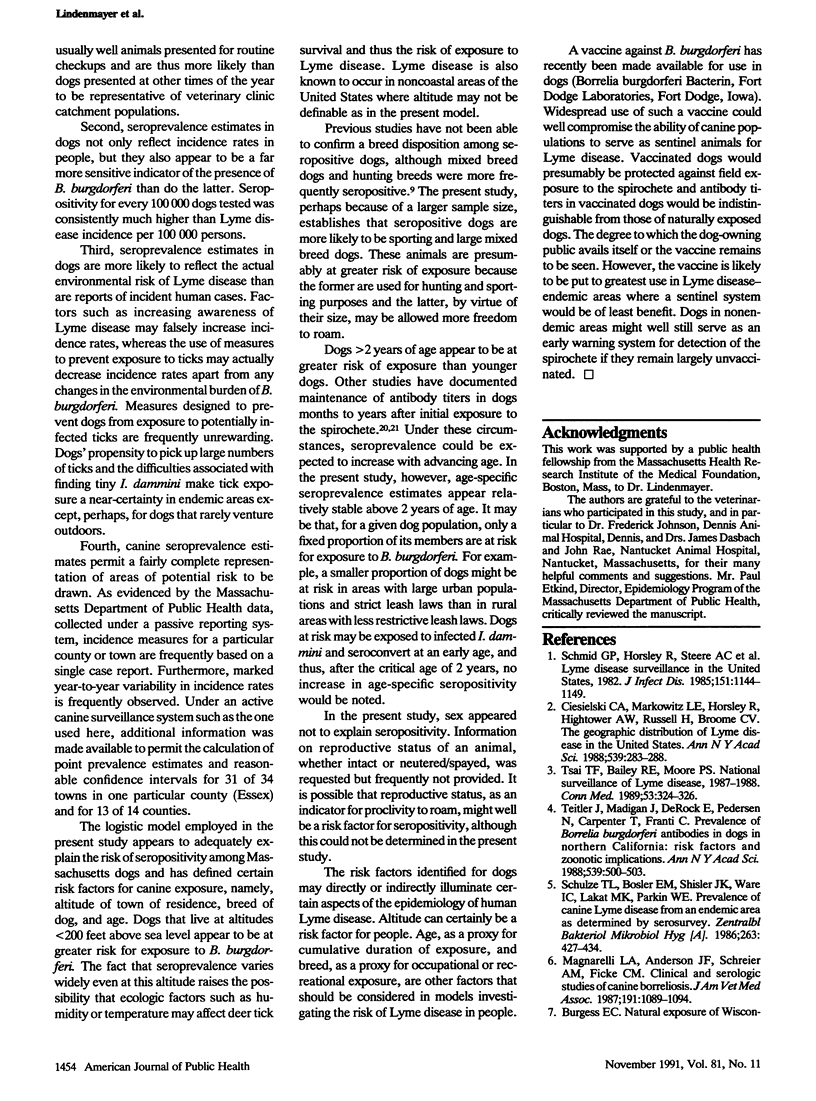
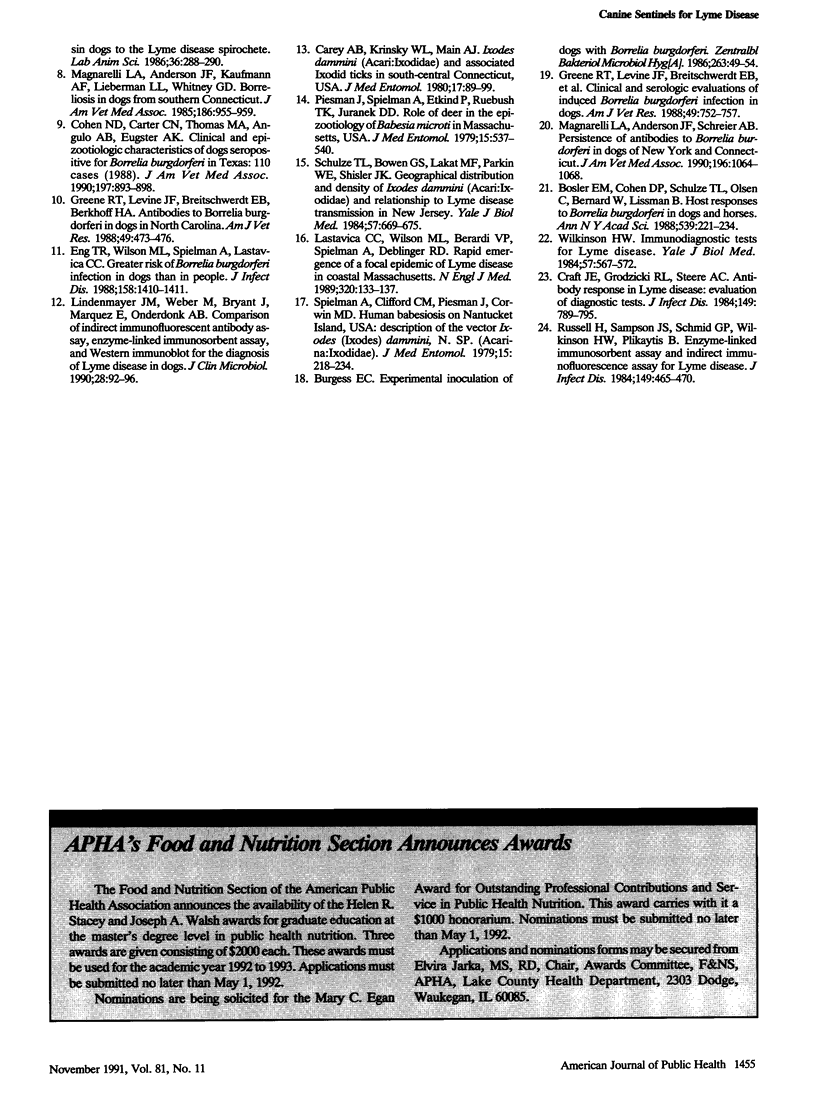
Selected References
These references are in PubMed. This may not be the complete list of references from this article.
- Bosler E. M., Cohen D. P., Schulze T. L., Olsen C., Bernard W., Lissman B. Host responses to Borrelia burgdorferi in dogs and horses. Ann N Y Acad Sci. 1988;539:221–234. doi: 10.1111/j.1749-6632.1988.tb31856.x. [DOI] [PubMed] [Google Scholar]
- Burgess E. C. Experimental inoculation of dogs with Borrelia burgdorferi. Zentralbl Bakteriol Mikrobiol Hyg A. 1986 Dec;263(1-2):49–54. doi: 10.1016/s0176-6724(86)80102-x. [DOI] [PubMed] [Google Scholar]
- Carey A. B., Krinsky W. L., Main A. J. Ixodes dammini (Acari: Ixodidae) and associated ixodid ticks in South-central Connecticut, USA. J Med Entomol. 1980 Jan 31;17(1):89–99. doi: 10.1093/jmedent/17.1.89. [DOI] [PubMed] [Google Scholar]
- Ciesielski C. A., Markowitz L. E., Horsley R., Hightower A. W., Russell H., Broome C. V. The geographic distribution of Lyme disease in the United States. Ann N Y Acad Sci. 1988;539:283–288. doi: 10.1111/j.1749-6632.1988.tb31862.x. [DOI] [PubMed] [Google Scholar]
- Cohen N. D., Carter C. N., Thomas M. A., Jr, Angulo A. B., Eugster A. K. Clinical and epizootiologic characteristics of dogs seropositive for Borrelia burgdorferi in Texas: 110 cases (1988). J Am Vet Med Assoc. 1990 Oct 1;197(7):893–898. [PubMed] [Google Scholar]
- Craft J. E., Grodzicki R. L., Steere A. C. Antibody response in Lyme disease: evaluation of diagnostic tests. J Infect Dis. 1984 May;149(5):789–795. doi: 10.1093/infdis/149.5.789. [DOI] [PubMed] [Google Scholar]
- Eng T. R., Wilson M. L., Spielman A., Lastavica C. C. Greater risk of Borrelia burgdorferi infection in dogs than in people. J Infect Dis. 1988 Dec;158(6):1410–1411. doi: 10.1093/infdis/158.6.1410. [DOI] [PubMed] [Google Scholar]
- Greene R. T., Levine J. F., Breitschwerdt E. B., Berkhoff H. A. Antibodies to Borrelia burgdorferi in dogs in North Carolina. Am J Vet Res. 1988 Apr;49(4):473–476. [PubMed] [Google Scholar]
- Greene R. T., Levine J. F., Breitschwerdt E. B., Walker R. L., Berkhoff H. A., Cullen J., Nicholson W. L. Clinical and serologic evaluations of induced Borrelia burgdorferi infection in dogs. Am J Vet Res. 1988 Jun;49(6):752–757. [PubMed] [Google Scholar]
- Lastavica C. C., Wilson M. L., Berardi V. P., Spielman A., Deblinger R. D. Rapid emergence of a focal epidemic of Lyme disease in coastal Massachusetts. N Engl J Med. 1989 Jan 19;320(3):133–137. doi: 10.1056/NEJM198901193200301. [DOI] [PubMed] [Google Scholar]
- Lindenmayer J., Weber M., Bryant J., Marquez E., Onderdonk A. Comparison of indirect immunofluorescent-antibody assay, enzyme-linked immunosorbent assay, and Western immunoblot for the diagnosis of Lyme disease in dogs. J Clin Microbiol. 1990 Jan;28(1):92–96. doi: 10.1128/jcm.28.1.92-96.1990. [DOI] [PMC free article] [PubMed] [Google Scholar]
- Magnarelli L. A., Anderson J. F., Kaufmann A. F., Lieberman L. L., Whitney G. D. Borreliosis in dogs from southern Connecticut. J Am Vet Med Assoc. 1985 May 1;186(9):955–959. [PubMed] [Google Scholar]
- Magnarelli L. A., Anderson J. F., Schreier A. B., Ficke C. M. Clinical and serologic studies of canine borreliosis. J Am Vet Med Assoc. 1987 Nov 1;191(9):1089–1094. [PubMed] [Google Scholar]
- Magnarelli L. A., Anderson J. F., Schreier A. B. Persistence of antibodies to Borrelia burgdorferi in dogs of New York and Connecticut. J Am Vet Med Assoc. 1990 Apr 1;196(7):1064–1068. [PubMed] [Google Scholar]
- Piesman J., Spielman A., Etkind P., Ruebush T. K., 2nd, Juranek D. D. Role of deer in the epizootiology of Babesia microti in Massachusetts, USA. J Med Entomol. 1979 Sep 4;15(5-6):537–540. doi: 10.1093/jmedent/15.5-6.537. [DOI] [PubMed] [Google Scholar]
- Russell H., Sampson J. S., Schmid G. P., Wilkinson H. W., Plikaytis B. Enzyme-linked immunosorbent assay and indirect immunofluorescence assay for Lyme disease. J Infect Dis. 1984 Mar;149(3):465–470. doi: 10.1093/infdis/149.3.465. [DOI] [PubMed] [Google Scholar]
- Schmid G. P., Horsley R., Steere A. C., Hanrahan J. P., Davis J. P., Bowen G. S., Osterholm M. T., Weisfeld J. S., Hightower A. W., Broome C. V. Surveillance of Lyme disease in the United States, 1982. J Infect Dis. 1985 Jun;151(6):1144–1149. doi: 10.1093/infdis/151.6.1144. [DOI] [PubMed] [Google Scholar]
- Schulze T. L., Bowen G. S., Lakat M. F., Parkin W. E., Shisler J. K. Geographical distribution and density of Ixodes dammini (Acari: Ixodidae) and relationship to Lyme disease transmission in New Jersey. Yale J Biol Med. 1984 Jul-Aug;57(4):669–675. [PMC free article] [PubMed] [Google Scholar]
- Spielman A., Clifford C. M., Piesman J., Corwin M. D. Human babesiosis on Nantucket Island, USA: description of the vector, Ixodes (Ixodes) dammini, n. sp. (Acarina: Ixodidae). J Med Entomol. 1979 Mar 23;15(3):218–234. doi: 10.1093/jmedent/15.3.218. [DOI] [PubMed] [Google Scholar]
- Tsai T. F., Bailey R. E., Moore P. S. National surveillance of Lyme disease, 1987-1988. Conn Med. 1989 Jun;53(6):324–326. [PubMed] [Google Scholar]
- Wilkinson H. W. Immunodiagnostic tests for Lyme disease. Yale J Biol Med. 1984 Jul-Aug;57(4):567–572. [PMC free article] [PubMed] [Google Scholar]


